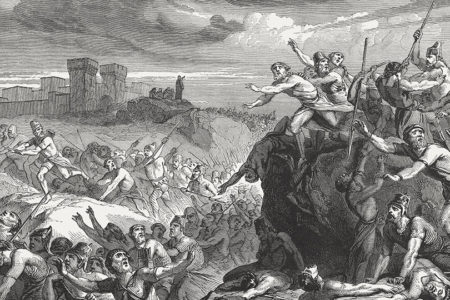Introduction to Obadiah
History is replete with small nations that strut across the world stage, proudly flex their political muscles, and then vanish into obscurity. Edom was such a nation, and its story was graphically detailed by the prophet Obadiah in the short book that bears his name.
Obadiah is the saga of fraternal twins (Esau and Jacob) who struggled in the womb of their mother, Rebekah (Gen. 25:22–23), and developed into two nations: Israel and Edom.
Esau was born first, entitling him to both the birthright and family blessing. However, Jacob obtained the birthright from Esau, who willingly traded it for a bowl of red pottage (vv. 33–34). Later, Jacob obeyed his mother’s instructions to trick his father, Isaac, into giving him the blessing of the firstborn as well (27:22–29, 33–37). Esau’s hatred for Jacob grew so bitter he vowed to kill him after Isaac died (v. 41).
Fearing Esau’s wrath, Jacob fled to Haran where he lived with Laban, his mother’s brother, for the next 20 years. In Haran, Jacob became a shepherd, married Laban’s two daughters (Leah and Rachel), and fathered 12 sons who later became the 12 tribes of Israel (27:42—30:24).
When Jacob returned to the land of Canaan, Esau met him in a spirit of genuine brotherly love and reconciliation (32:3—33:17). There seemed to be no animosity between the brothers when they buried Isaac, their father (35:29).
Esau’s descendants were the Edomites who settled in Mount Seir, situated on the southeastern edge of the Dead Sea, from the Zered River to the Gulf of Aqaba (32:3; 36:20–21). Edom’s capital was Sela (called Petra today), thought to be impregnable because of its mountainous location (Isa. 42:11).
The Edomites developed a fierce, independent spirit that fostered pride and a false sense of security. They saw themselves as unconquerable.
A major trade route called the King’s Highway (running north and south) passed by Seir. Caravans traveling the route were vulnerable to the Edomites, who often swept down from their rocky stronghold to rob them.
Though Jacob and Esau had been brothers, the Edomites developed a deep-seated hatred for Israel. Their animosity first erupted when they refused to let the Israelites pass through their land on the way to Canaan from Egypt (Num. 20:14–21; 21:4; Jud. 11:17–18).
But God instructed Israel not to hate Edom, because they were related (Dt. 23:7). Hostility dominated their relationship (Ezek. 35:5), especially during the days of King Saul (1 Sam. 14:47), King David (2 Sam. 8:13–16), Joab (1 Ki. 11:16), and King Solomon (1 Ki. 11:14, 17–22).
Edom’s hatred reached its climax when the country helped the Babylonians conquer Judah in 586 BC.
About the Book
Obadiah is the shortest book in the Old Testament, having only 21 verses, 670 words, one command, four questions, no promises, 30 predictions, 12 verses of prophecy, five verses of fulfilled prophecy, seven verses of unfulfilled prophecy, and three distinct messages from God.1
The theme is Edom’s destruction. The key verse is Obadiah 15, and the key words in Obadiah are Edom/Esau (nine times) and cut off (three times).2
Author. Obadiah is mentioned as the author in verse 1 only. His name means “worshiper of Jehovah.” Nothing is known about his family, residence, occupation, or age. Nor is it known whether he came from a lowly peasant family or an upper-class one. Thirteen different men in the Bible are named Obadiah.
Date. The exact date of Obadiah’s prophecy is also unknown. Scholars suggest three possibilities:
- During the reign of Jehoram (Joram, between 848 and 841 BC), when Edom revolted against Judah (2 Ki. 8:20–22; 2 Chr. 21:8) and the Philistines and Arabians attacked Judah (2 Chr. 21:16–17).
- During the reign of Ahaz (731–715 BC), when Edom attacked Judah (28:17).
- During Babylon’s invasion of Judah in 586 BC.
Conservative scholars are divided between the first and third views.
Problems exist with the first view, which does not seem compatible with Judah’s destruction, mentioned in Obadiah 10–14. Though the Philistines and Arabians did attack Judah during Joram’s reign, nothing indicates Judah was destroyed.
The third view seems the most favorable because it coincides with the exile of most of the Jewish people to Babylon for 70 years. Other prophecies indicate Edom assisted Babylon in Judah’s destruction at that time (Ps. 137:7; Jer. 49:9–16; Lam. 4:21–22; Ezek. 25:12–14; 35:1–15).
Addressees. In Obadiah, God addresses three groups: (1) an unidentified group of Judeans, probably the prophet himself, and the Jewish people taken into exile; (2) Edom, which helped Babylon conquer Israel; and (3) surrounding nations calling for war against Edom (Obad. 1–2).
Message. Although it is an obscure book, tucked away in the Minor Prophets and seldom read, Obadiah carries a contemporary message that 21st-century individuals and nations should read and heed.
Like many countries today, Edom was proud, prejudiced, and prosperous and persecuted those living around it. The Edomites had been lulled into a false sense of security, believing themselves indestructible because of their seemingly secure, strategic location in the mountains of Seir.
But mountains mean nothing to God. He eventually judged the nation for helping the Babylonians destroy Judah (Ps. 137:7), using the Nabatean Arabs to destroy Edom and bring the Edomites under Nabatean control (Jer. 49:7–22; Ezek. 25:12–14).
Edom was expelled from Seir and stripped of its land and national identity. The Edomites later settled in southern Judah where they became known by the Greek name Idumeans.
Although Israel was divested of its holdings, God promises Israel a future, when the nation will experience “deliverance” (salvation), “possess their possessions” (recover land previously owned), be characterized by “holiness” (Obad. 17), and destroy Esau’s descendants (v. 18).
God also promises the Jewish people will occupy all the territory He promised them in the Abrahamic Covenant (vv. 19–21; cf. Gen. 15:18–21) as a unified people (Ezek. 37:15–23). These prophecies will be fulfilled at Christ’s return to set up His Millennial Kingdom on Earth.
ENDNOTES
- Finis Jennings Dake, “Summary of Obadiah,” The Dake Annotated Reference Bible (Lawrenceville, GA: Dake Bible Sales, 1963), 899.
- Ibid.









I enjoyed the history, God bless you